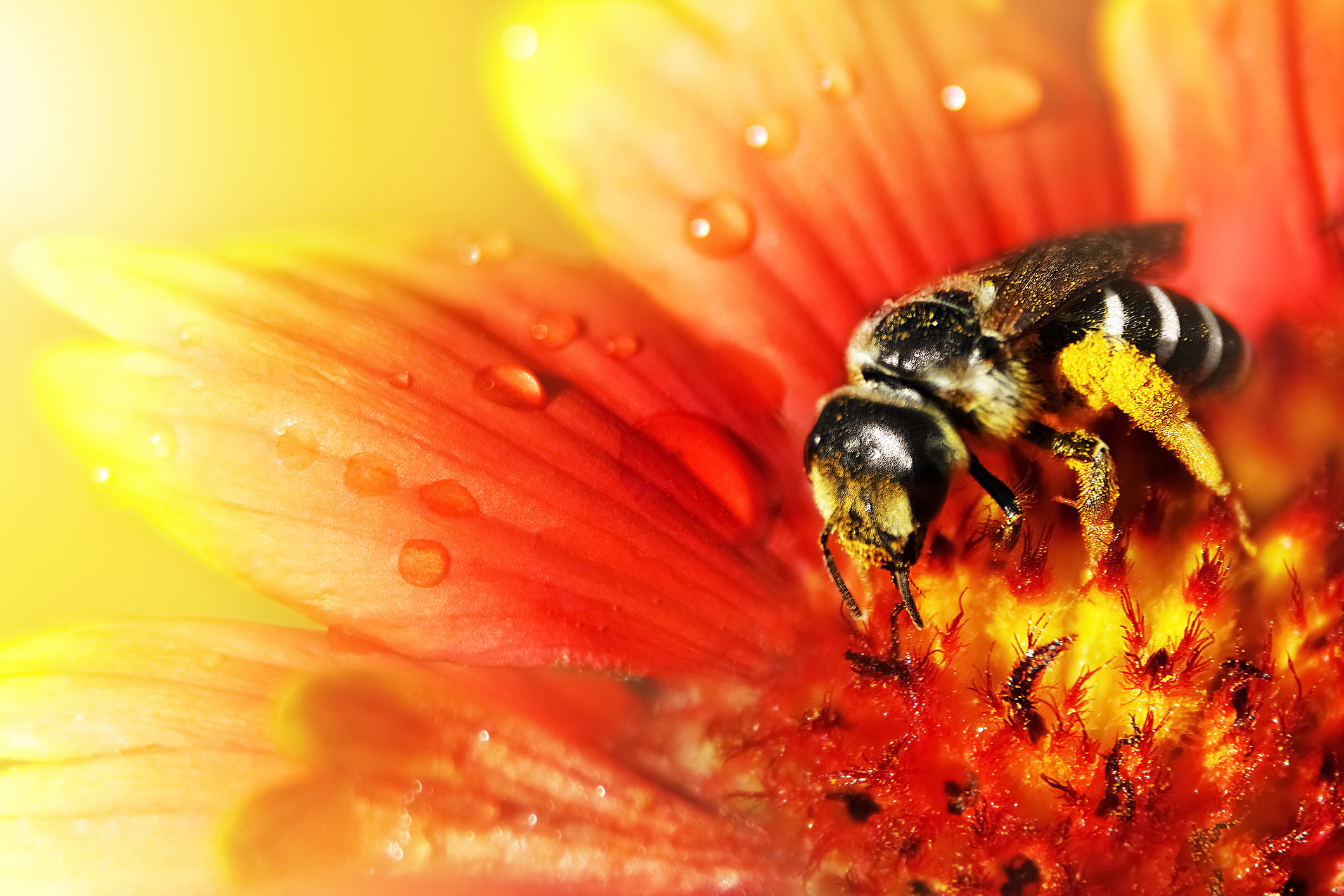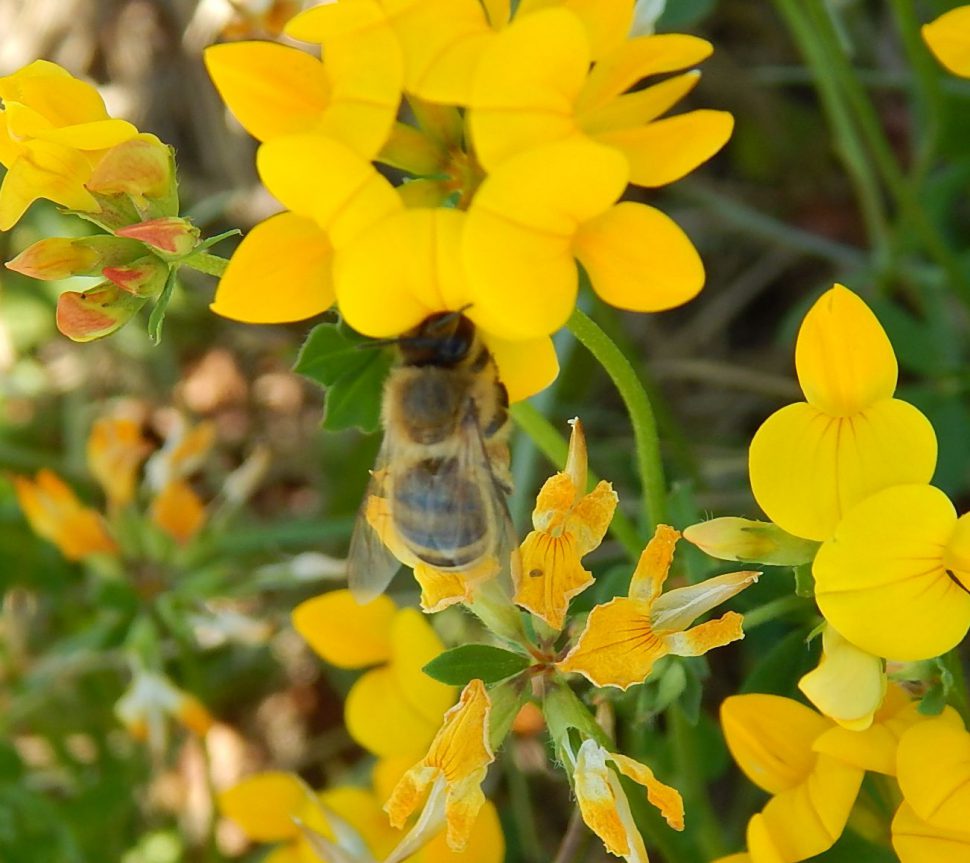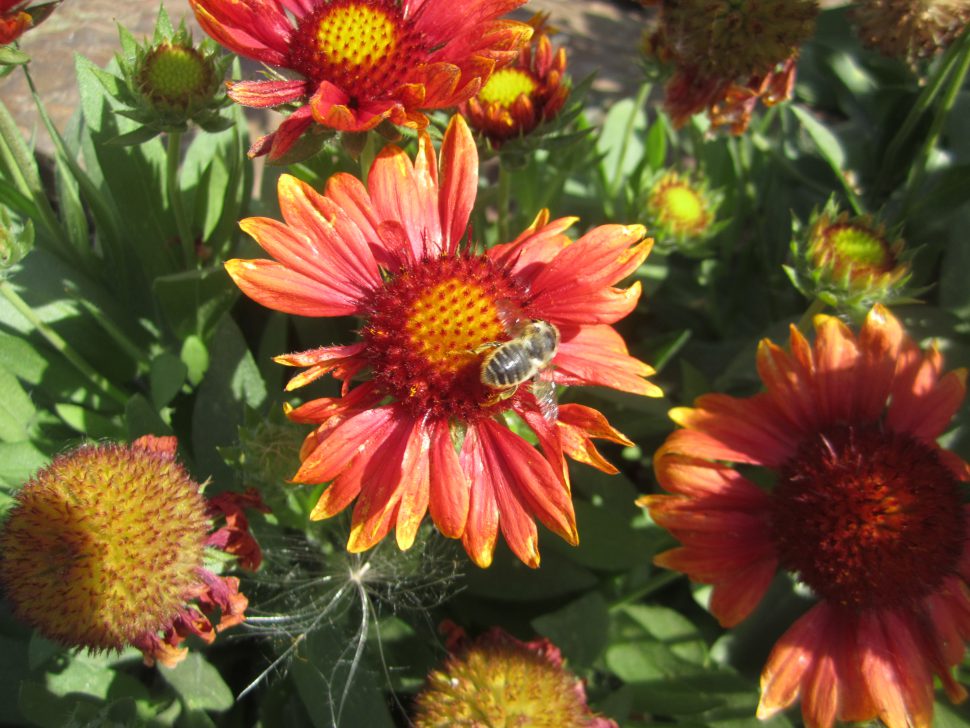
Imagine life without chocolate, walnuts, cinnamon or vanilla for baking, or eating? What about never eating a potato, tomato or apple again? This possibility is no longer far-reaching as pollinators continue their serious decline due to a number of factors, including environmental. Thirty-five percent of global food production is pollinator-dependent, plus meat and dairy (milk, yogurt, butter, cheese) production requires pollinators for alfalfa and clover. Peaches, strawberries, grapes, cauliflower, broccoli, green beans, lettuce, onions, cashews, sesame seeds, mustard and even sugar cane – to name just a few commonly eaten foods – all require pollination. In fact, McDonald’s signature Big Mac, fries and Coke would not exist without pollinators [1].
Bees and other pollinating insects improve food production for two billion small farmers. If pollination is managed well, their crop yields can increase by a median of 24 percent. Pollinators also increase food quality. According to the United Nations Food and Agricultural Organization (FAO), “If a plant has been well pollinated, meaning it received a large amount of pollen, a larger and more uniform fruit will develop. Round apples, for instance, would imply sufficient pollination, whereas misshaped apples would imply insufficient or imbalanced pollination. Generally, plants put more of their resources into pollinated fruits, increasing quality and taste [2].”
Up to 25 percent of the United States’ USD $140 billion in agriculture exports are vulnerable to loss of pollinators [1]. Among nature-friendly pollinator insects, bees extend vital cross-pollination services to more than 70 percent of global plant species directly associated with agriculture. Hence, they play a very significant role with respect to global human food production, as well as economic security. Honey bees alone cross-pollinate worldwide about USD $200 billion in crops [3]. In the United States, crop benefits from these native insect pollinators were valued at more than USD $9 billion dollars in 2009 [4] – $6.8 billion from honey bees and $3.1 billion from native (indigenous) bees [1].
Pollination is an extremely important natural (biological) process for the sexual reproduction of many plant species. As indicated above, a large number include important food and cash crops, ornamentals, vegetables and wildflowers. For example, seed canola and seed alfalfa constitute enormous industry-scale agricultural crops across North America, which are heavily dependent upon local bees for cross-pollination. Several species of native bees and honey bees are dependent on these extensive crop production systems for sustaining their colonies. Unfortunately, vulnerable native bee populations across North America are undergoing continued, serious decline due to a number of factors. These include, but are not limited to, (1) indiscriminate spraying of toxic pesticides in agricultural fields, (2) devastating parasitic diseases of bees that are weakening bee colonies, (3) rapid colony collapses and (4) lack of foraging plant species for bees to find suitable food and nutrition throughout the long growing seasons.
Colony Collapse Disorder
Among factors responsible for reduction of global bee populations, the incidence of Colony Collapse Disorder (CCD), with unusually high numbers of honey bee colony losses, has been covered extensively in popular media, as well as advanced scientific research. Tens of millions of honey bee colonies have been lost worldwide, including an estimated 10-15 million in the United States at a direct economic loss of up to USD $3 billion [4]. Hence, serious concerns have been expressed by global honeybee experts regarding CCD and abnormal loss of honey bee colonies. Although an average loss of 5-10 percent in honey bee colonies per annum is considered normal in the apiculture industry, it cannot account for the unprecedented loss of tens of millions of honey bee colonies across the globe. It is important to mention that CCD is not restricted to the Americas; it has been reported in Asia, Europe and Australia.
CCD is diagnosed when a majority of the worker bee population serving a particular hive completely disappear without any apparent reason or cause. As a consequence, the colony collapses due to lack of regular services by worker bees. The latter collect quality nectar and pollen, and protect, repair and care for the queen and immature bee members of the hive. CCD is determined by the complete absence of adult bees in a honey bee colony with little or no accumulation of dead honey bees either within or around the hive. Actual factors causing CCD are not well understood and are currently believed to be a cumulative impact of several factors. They include honey bee parasitic diseases and/or infections, habitat loss, poor quality of honey bee genetics, low immunogenic response among colony members (immuno-deficiencies or immuno-suppression), lack of proper bee nutrition (under nutrition or malnutrition), variability in maintaining the necessary temperature of broods, exposure to toxic chemicals, environmental pollution and abnormal nature of bee migration, to mention a few.
 Honey Bee-Courtesy Saikat Kumar Basu
Honey Bee-Courtesy Saikat Kumar Basu
Decline of vulnerable honey bees, as well as native bee populations across North America, could prove to be extremely detrimental to future agricultural potential, stability of fragile local ecosystems and local economies. It is, therefore, necessary to take concrete conservation steps to protect these populations through best agri-management practices. Two important steps include: 1.) reduction of heavy pesticide applications on pollinator-dependent crops and agricultural fields, and 2.) avoidance of spraying pesticides on bright, sunny days when bees are most active and industriously foraging on crops in large numbers. Extensive application of chemicals must be avoided to prevent resistant parasites from emerging, which can continue to devastate surviving bee colonies. Hence, long-term sustainable solutions will be important to deal with the challenges of efficient bee conservation.
Bee Sanctuaries & Gardens
An important step toward advancing bee conservation is to create suitable bee sanctuaries or bee gardens, or pollinator gardens supported by bee/pollinator friendly wildflower species and/or annual/perennial forage crops/plants. Developing suitable pollinator/bee mixes is vital as well for accommodating pollinator/bee friendly wildflower and/or annual/perennial forage crop species. Seed mixes can flower across seasons to provide foraging opportunities for extensive periods beyond the standard crop growing season using early-, mid- or late-flowering wildflowers and/or annual or perennial forages.
Target sites for establishing suitable pollinator habitats or bee sanctuaries could be home lawns, kitchen gardens, backyard gardens, municipal parks or gardens, open and/or unused spaces in cities and boulevards. Sites along various freshwater bodies like ponds, swamps, ditches, lakes, irrigation canals and undisturbed corners of riverine areas can also serve as ideal bee or pollinator habitats. Furthermore, unused parts of existing crop lands, fringe farm areas, undisturbed and/or difficult to access parts of farms, weedy patches, abandoned farm areas and shelterbelts can help support and conserve native bee populations. Vast areas under different irrigation districts, which are left to weeds, could be utilized for establishing suitable bee sanctuaries. Care must be taken to stay away from pesticide use on these sites to avoid damaging and/or impacting thriving local bee populations.
One challenge of growing wildflower pollinator habitats or wildflower exclusive bee sanctuaries is that not all target pollinator wildflower species can grow and flower well under standard agronomic conditions. This is due to lack of knowledge and available agronomic information on production protocols under standard field conditions. Many species are data deficient and, hence, need research in identifying their specific agronomic parameters and necessary growth conditions for successful germination, growth and flowering. While they may grow successfully under limited scale production, large-scale commercial production of farmers’ fields is a substantial challenge at this time. Hence, it is important to look for mixes that include both wildflowers and annual/perennial pollinator friendly forage species like different species of clovers, sweet clovers, trefoils, vetches, wild mustard, radish and sainfoin. Adding pollinator friendly legume crops can help improve soil profile and fix atmospheric nitrogen. Several abandoned and agronomically unsuitable areas could also be reclaimed by using mixes with salt tolerant grasses.
Multiple-Use Ecosystem Strategies
The above strategy and practices can help conserve native bees and other pollinators while providing habitats for smaller mammals and birds. Therefore, suitable pollinator mixes have multiple ecosystem uses and applications. In 2015, US President Obama declared the first comprehensive national strategy to combat challenges impacting bees and other important, farmer friendly, biological pollinator species across the United States. The plan called for ecological restoration of approximately seven million acres using a rich diversity of flowering plants for establishing forage areas for bees and other key pollinators.
Creation or restoration of these habitats can help a wide diversity of local species under a Multiple Tier Conservation Model (MTCM) approach. Benefits of integrating freshwater aquatic habitat conservation extend to a multitude of local native species. Pollinator mix established along a natural and/or artificial water body will develop into a micro ecosystem in a few years, which will attract other insect species and small birds. An Integrated Ecological Habitat Development for Bees, Birds and Fishes (IEHD-BBF) could include all three species, if the local water body is initially well-stocked with local fishes. This will then attract resident and migratory aquatic birds, ground nesting pheasants, small mammals, reptiles and amphibians into these unique ecological habitats. These two models (MTCM and IEHD-BBF) can target multiple, trophic levels of local ecosystems and cater to a wide range of native species and wildlife, thus establishing and enriching local natural biodiversity.
 Brown-bellied Bumble Bee-Courtesy Saikat Kumar Basu
Brown-bellied Bumble Bee-Courtesy Saikat Kumar Basu
Multiple-site agronomic trails at different latitudes investigating various combinations of annual/perennial forages and grasses and native wildflowers need to be researched to design appropriate mixes for different agro-climatic regions across North America. Pollinator mixes, therefore, have the potential to secure a better future for multiple species of natural (biological) pollinators through an environmentally friendly, economically affordable, low maintenance, sustainable approach.
Joint Integration Solutions
Bee conservation challenges are similar in the United States and Canada. Hence, a joint US-Canadian effort across different ecosystems could help conserve bees at the ground level more successfully. If Mexico is also included in this conservation drive, it could serve as a win-win situation for the entire North American continent, which will better secure a common future in protecting agriculture and apiculture industries. Such an approach can boost innovative pollinator conservation while looking for opportunities to integrate research and development in the three countries under a comprehensive conservation program. A joint effort can also help educate and make farmers, chemical companies, academics, researchers and ordinary citizens aware of the importance of pollinator conservation and the interdependent agriculture and apiculture industry economies.
It is vital for everyone to understand not only the grave crisis affecting pollinators but also their personal role in protecting these vital creatures. This is a national issue that requires strong support to secure the future of both North America’s ecology and its economy. Loss of bees and other insect pollinators means significant loss to the stability of natural ecosystems, which support agricultural, horticultural and apicultural productivity. To save pollinators, substantial citizen action is necessary along with ground-level research and surveys to understand the complex challenges they are facing. Taking appropriate steps to protect them is the only way to ensure global food and economic security for today and future generations.
Acknowledgement: Performance Seed, Lethbridge AB Canada
Top Image Credit: iStock/Delbars
References:
- Environmental Protection Agency; Food Security and Pollinators, Vicki Wojcik, 2016; https://www.epa.gov/sites/production/files/2016-08/documents/vicki_wojcik_6-23-16.pdf
- Food and Agriculture Organization of the United States (FAO); The Power of Pollinators: Why More Bees Mean Better Food, 2016; http://www.fao.org/zhc/detail-events/en/c/428504.
- Intergovernmental Science-Policy Platform on Biodiversity and Ecosystem Services; The Assessment Report on Pollinators, Pollination and Food Production, 2017; https://www.ipbes.net/system/tdf/downloads/pdf/individual_chapters_pollination_20170305.pdf?file=1&type=node&id=15248.
- The White House, President Barack Obama; Fact Sheet: The Economic Challenge Posed by Declining Pollinator Populations, 2014; https://obamawhitehouse.archives.gov/the-press-office/2014/06/20/fact-sheet-economic-challenge-posed-declining-pollinator-populations.
Research and Reports:

